BUS4001: In-depth Analysis of Harrods' Business Environment Report
VerifiedAdded on 2023/06/10
|13
|3966
|123
Report
AI Summary
This report provides a comprehensive analysis of Harrods' business environment. It begins with an introduction outlining the scope and objectives, followed by an examination of Harrods' legal structure, operations, and purpose. The report then delves into stakeholder analysis, identifying and prioritizing key stakeholders such as employees, shareholders, customers, and regulatory authorities. A detailed analysis of the business environment using PESTLE framework is then presented, considering political, economic, social, technological, and environmental factors impacting Harrods. The report further applies Porter's Five Forces model to assess the competitive landscape. The report concludes with a summary of findings and recommendations, drawing on the analysis to provide insights into Harrods' strategic planning and market positioning within the UK retail industry. The report considers the impact of market structure, competitive forces, and external factors on Harrods' performance and future prospects.
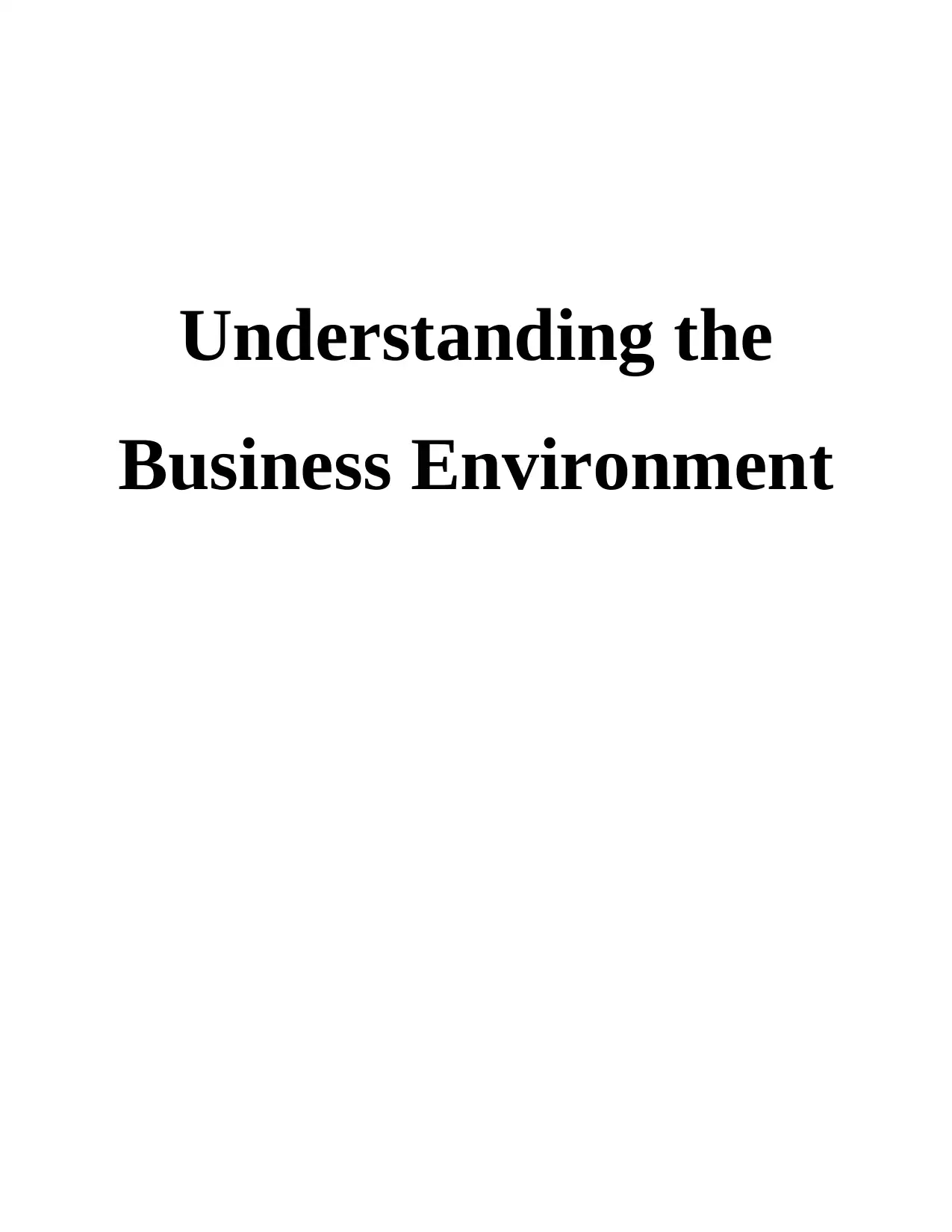
Understanding the
Business Environment
Business Environment
Paraphrase This Document
Need a fresh take? Get an instant paraphrase of this document with our AI Paraphraser
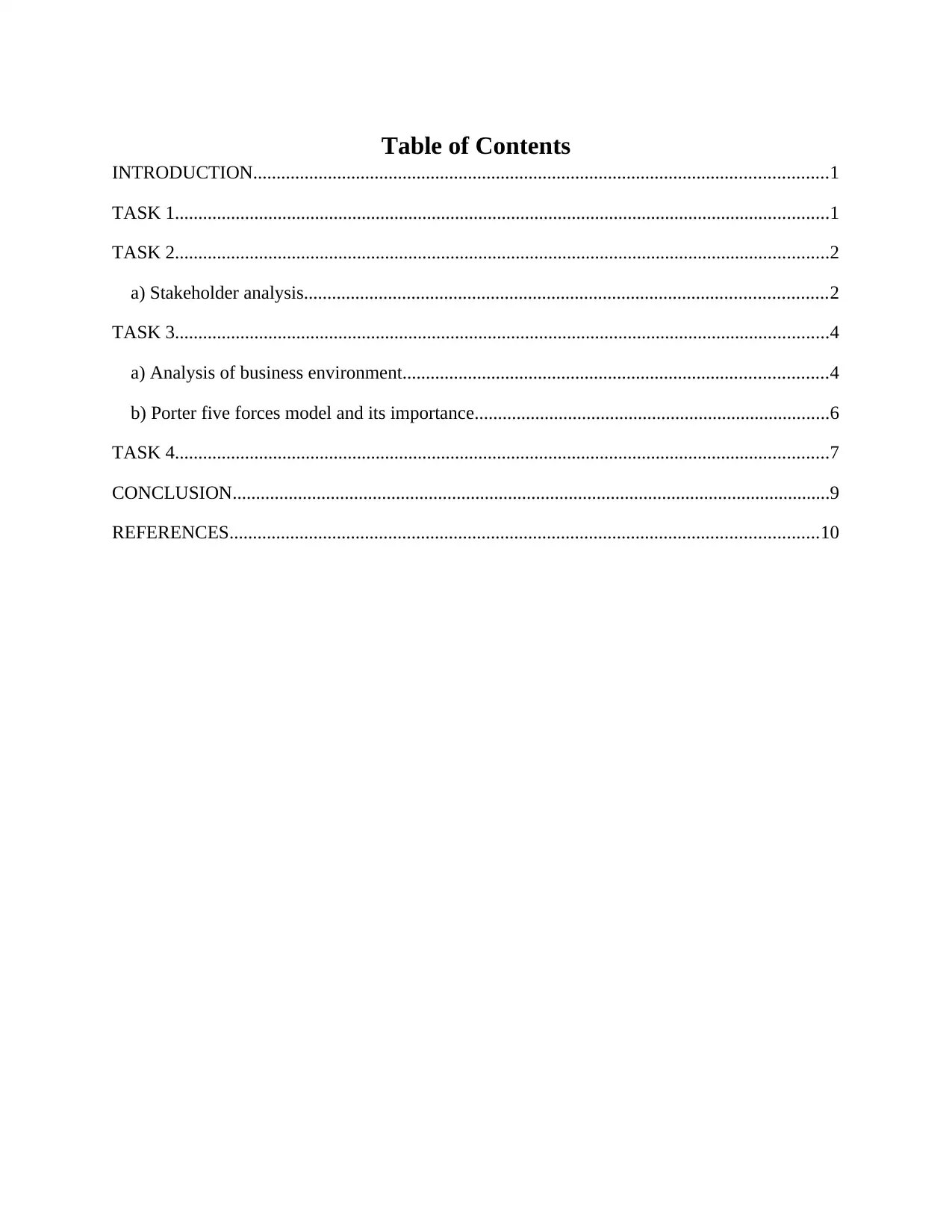
Table of Contents
INTRODUCTION...........................................................................................................................1
TASK 1............................................................................................................................................1
TASK 2............................................................................................................................................2
a) Stakeholder analysis................................................................................................................2
TASK 3............................................................................................................................................4
a) Analysis of business environment...........................................................................................4
b) Porter five forces model and its importance............................................................................6
TASK 4............................................................................................................................................7
CONCLUSION................................................................................................................................9
REFERENCES..............................................................................................................................10
INTRODUCTION...........................................................................................................................1
TASK 1............................................................................................................................................1
TASK 2............................................................................................................................................2
a) Stakeholder analysis................................................................................................................2
TASK 3............................................................................................................................................4
a) Analysis of business environment...........................................................................................4
b) Porter five forces model and its importance............................................................................6
TASK 4............................................................................................................................................7
CONCLUSION................................................................................................................................9
REFERENCES..............................................................................................................................10
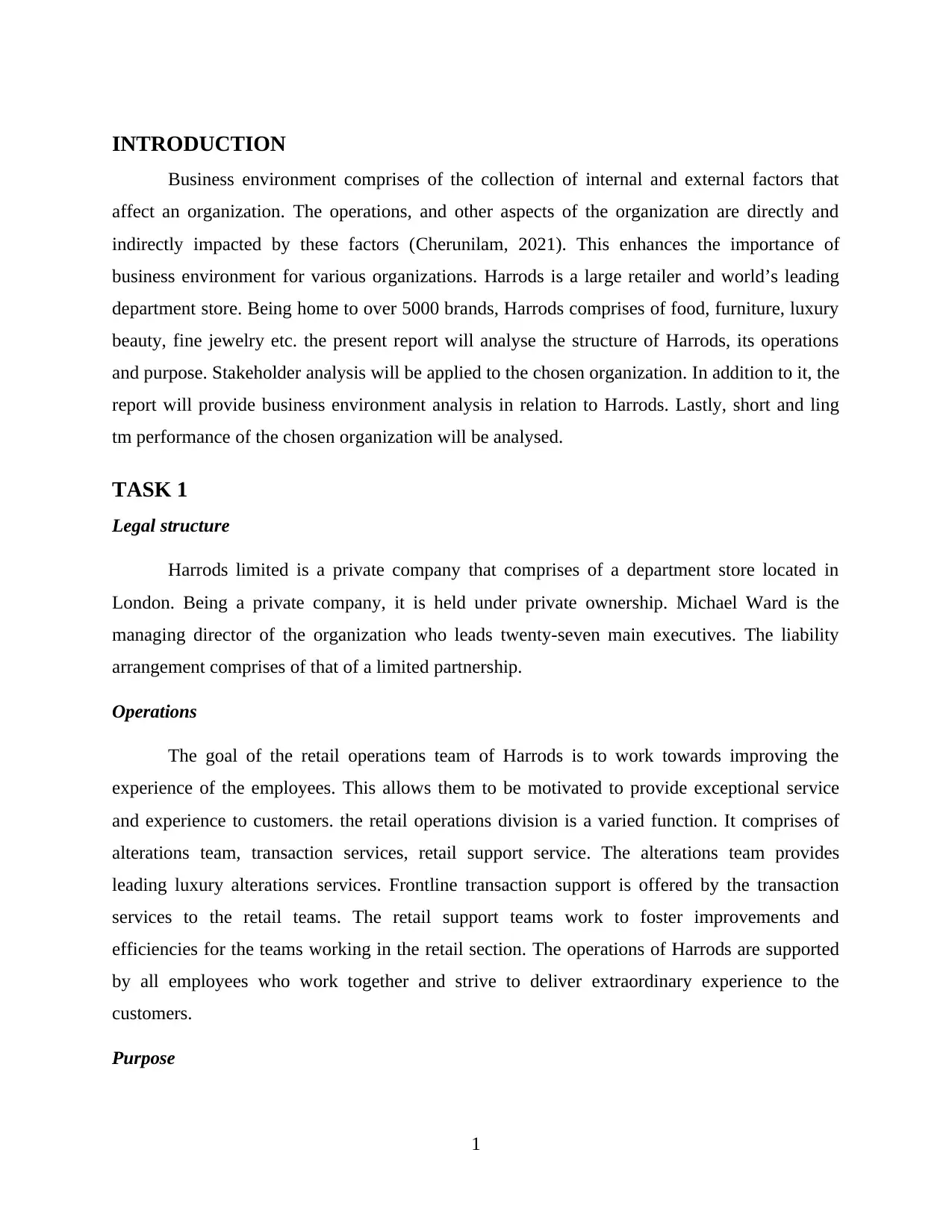
INTRODUCTION
Business environment comprises of the collection of internal and external factors that
affect an organization. The operations, and other aspects of the organization are directly and
indirectly impacted by these factors (Cherunilam, 2021). This enhances the importance of
business environment for various organizations. Harrods is a large retailer and world’s leading
department store. Being home to over 5000 brands, Harrods comprises of food, furniture, luxury
beauty, fine jewelry etc. the present report will analyse the structure of Harrods, its operations
and purpose. Stakeholder analysis will be applied to the chosen organization. In addition to it, the
report will provide business environment analysis in relation to Harrods. Lastly, short and ling
tm performance of the chosen organization will be analysed.
TASK 1
Legal structure
Harrods limited is a private company that comprises of a department store located in
London. Being a private company, it is held under private ownership. Michael Ward is the
managing director of the organization who leads twenty-seven main executives. The liability
arrangement comprises of that of a limited partnership.
Operations
The goal of the retail operations team of Harrods is to work towards improving the
experience of the employees. This allows them to be motivated to provide exceptional service
and experience to customers. the retail operations division is a varied function. It comprises of
alterations team, transaction services, retail support service. The alterations team provides
leading luxury alterations services. Frontline transaction support is offered by the transaction
services to the retail teams. The retail support teams work to foster improvements and
efficiencies for the teams working in the retail section. The operations of Harrods are supported
by all employees who work together and strive to deliver extraordinary experience to the
customers.
Purpose
1
Business environment comprises of the collection of internal and external factors that
affect an organization. The operations, and other aspects of the organization are directly and
indirectly impacted by these factors (Cherunilam, 2021). This enhances the importance of
business environment for various organizations. Harrods is a large retailer and world’s leading
department store. Being home to over 5000 brands, Harrods comprises of food, furniture, luxury
beauty, fine jewelry etc. the present report will analyse the structure of Harrods, its operations
and purpose. Stakeholder analysis will be applied to the chosen organization. In addition to it, the
report will provide business environment analysis in relation to Harrods. Lastly, short and ling
tm performance of the chosen organization will be analysed.
TASK 1
Legal structure
Harrods limited is a private company that comprises of a department store located in
London. Being a private company, it is held under private ownership. Michael Ward is the
managing director of the organization who leads twenty-seven main executives. The liability
arrangement comprises of that of a limited partnership.
Operations
The goal of the retail operations team of Harrods is to work towards improving the
experience of the employees. This allows them to be motivated to provide exceptional service
and experience to customers. the retail operations division is a varied function. It comprises of
alterations team, transaction services, retail support service. The alterations team provides
leading luxury alterations services. Frontline transaction support is offered by the transaction
services to the retail teams. The retail support teams work to foster improvements and
efficiencies for the teams working in the retail section. The operations of Harrods are supported
by all employees who work together and strive to deliver extraordinary experience to the
customers.
Purpose
1
⊘ This is a preview!⊘
Do you want full access?
Subscribe today to unlock all pages.

Trusted by 1+ million students worldwide
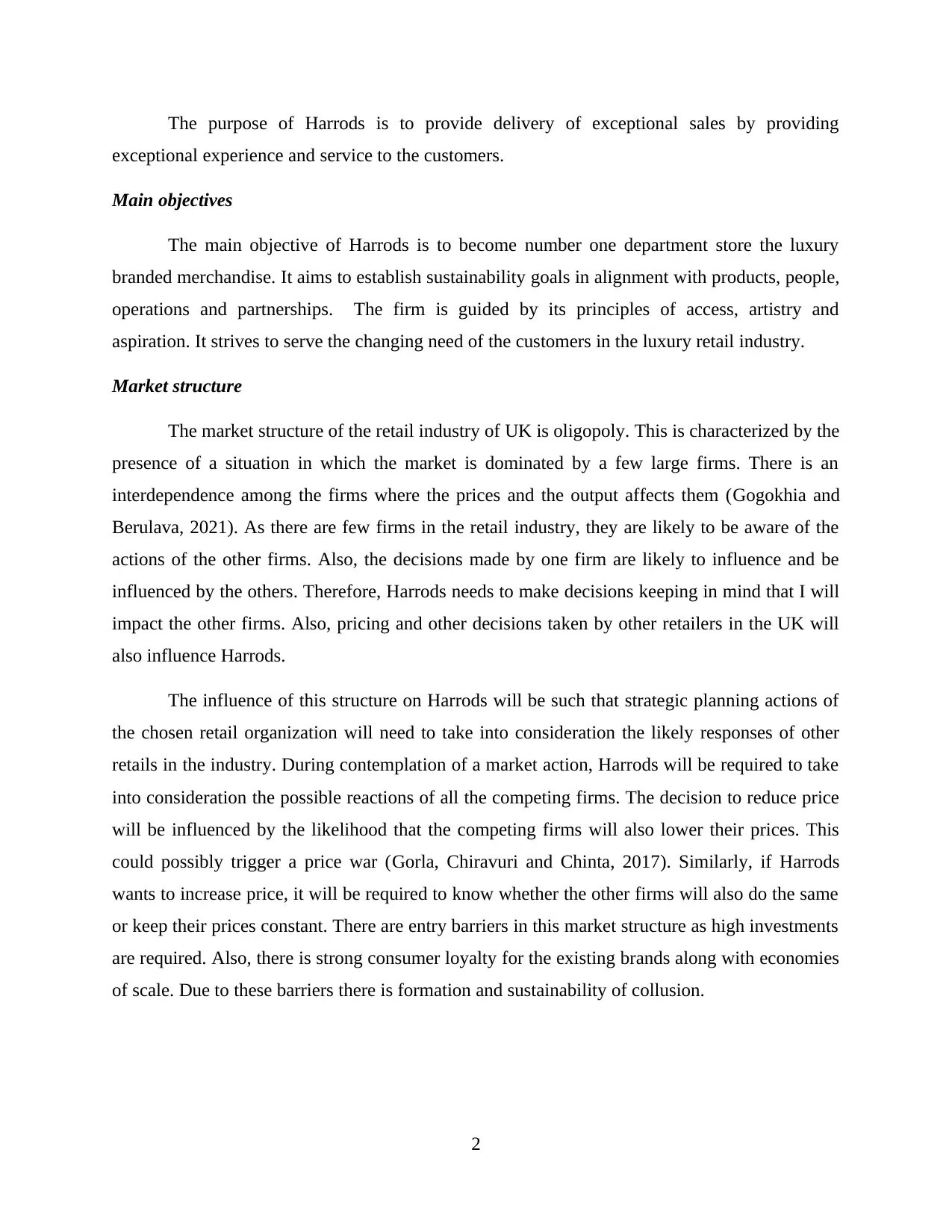
The purpose of Harrods is to provide delivery of exceptional sales by providing
exceptional experience and service to the customers.
Main objectives
The main objective of Harrods is to become number one department store the luxury
branded merchandise. It aims to establish sustainability goals in alignment with products, people,
operations and partnerships. The firm is guided by its principles of access, artistry and
aspiration. It strives to serve the changing need of the customers in the luxury retail industry.
Market structure
The market structure of the retail industry of UK is oligopoly. This is characterized by the
presence of a situation in which the market is dominated by a few large firms. There is an
interdependence among the firms where the prices and the output affects them (Gogokhia and
Berulava, 2021). As there are few firms in the retail industry, they are likely to be aware of the
actions of the other firms. Also, the decisions made by one firm are likely to influence and be
influenced by the others. Therefore, Harrods needs to make decisions keeping in mind that I will
impact the other firms. Also, pricing and other decisions taken by other retailers in the UK will
also influence Harrods.
The influence of this structure on Harrods will be such that strategic planning actions of
the chosen retail organization will need to take into consideration the likely responses of other
retails in the industry. During contemplation of a market action, Harrods will be required to take
into consideration the possible reactions of all the competing firms. The decision to reduce price
will be influenced by the likelihood that the competing firms will also lower their prices. This
could possibly trigger a price war (Gorla, Chiravuri and Chinta, 2017). Similarly, if Harrods
wants to increase price, it will be required to know whether the other firms will also do the same
or keep their prices constant. There are entry barriers in this market structure as high investments
are required. Also, there is strong consumer loyalty for the existing brands along with economies
of scale. Due to these barriers there is formation and sustainability of collusion.
2
exceptional experience and service to the customers.
Main objectives
The main objective of Harrods is to become number one department store the luxury
branded merchandise. It aims to establish sustainability goals in alignment with products, people,
operations and partnerships. The firm is guided by its principles of access, artistry and
aspiration. It strives to serve the changing need of the customers in the luxury retail industry.
Market structure
The market structure of the retail industry of UK is oligopoly. This is characterized by the
presence of a situation in which the market is dominated by a few large firms. There is an
interdependence among the firms where the prices and the output affects them (Gogokhia and
Berulava, 2021). As there are few firms in the retail industry, they are likely to be aware of the
actions of the other firms. Also, the decisions made by one firm are likely to influence and be
influenced by the others. Therefore, Harrods needs to make decisions keeping in mind that I will
impact the other firms. Also, pricing and other decisions taken by other retailers in the UK will
also influence Harrods.
The influence of this structure on Harrods will be such that strategic planning actions of
the chosen retail organization will need to take into consideration the likely responses of other
retails in the industry. During contemplation of a market action, Harrods will be required to take
into consideration the possible reactions of all the competing firms. The decision to reduce price
will be influenced by the likelihood that the competing firms will also lower their prices. This
could possibly trigger a price war (Gorla, Chiravuri and Chinta, 2017). Similarly, if Harrods
wants to increase price, it will be required to know whether the other firms will also do the same
or keep their prices constant. There are entry barriers in this market structure as high investments
are required. Also, there is strong consumer loyalty for the existing brands along with economies
of scale. Due to these barriers there is formation and sustainability of collusion.
2
Paraphrase This Document
Need a fresh take? Get an instant paraphrase of this document with our AI Paraphraser
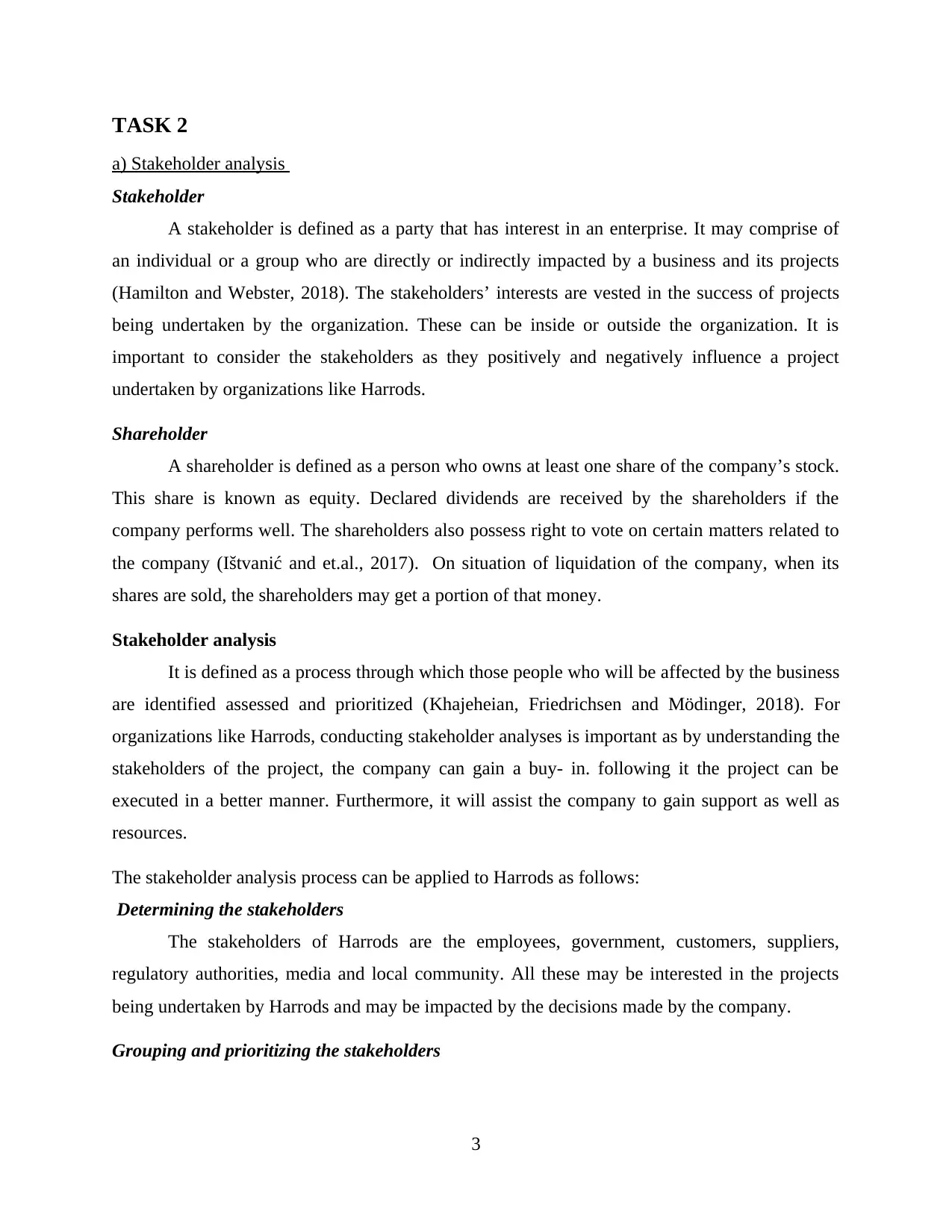
TASK 2
a) Stakeholder analysis
Stakeholder
A stakeholder is defined as a party that has interest in an enterprise. It may comprise of
an individual or a group who are directly or indirectly impacted by a business and its projects
(Hamilton and Webster, 2018). The stakeholders’ interests are vested in the success of projects
being undertaken by the organization. These can be inside or outside the organization. It is
important to consider the stakeholders as they positively and negatively influence a project
undertaken by organizations like Harrods.
Shareholder
A shareholder is defined as a person who owns at least one share of the company’s stock.
This share is known as equity. Declared dividends are received by the shareholders if the
company performs well. The shareholders also possess right to vote on certain matters related to
the company (Ištvanić and et.al., 2017). On situation of liquidation of the company, when its
shares are sold, the shareholders may get a portion of that money.
Stakeholder analysis
It is defined as a process through which those people who will be affected by the business
are identified assessed and prioritized (Khajeheian, Friedrichsen and Mödinger, 2018). For
organizations like Harrods, conducting stakeholder analyses is important as by understanding the
stakeholders of the project, the company can gain a buy- in. following it the project can be
executed in a better manner. Furthermore, it will assist the company to gain support as well as
resources.
The stakeholder analysis process can be applied to Harrods as follows:
Determining the stakeholders
The stakeholders of Harrods are the employees, government, customers, suppliers,
regulatory authorities, media and local community. All these may be interested in the projects
being undertaken by Harrods and may be impacted by the decisions made by the company.
Grouping and prioritizing the stakeholders
3
a) Stakeholder analysis
Stakeholder
A stakeholder is defined as a party that has interest in an enterprise. It may comprise of
an individual or a group who are directly or indirectly impacted by a business and its projects
(Hamilton and Webster, 2018). The stakeholders’ interests are vested in the success of projects
being undertaken by the organization. These can be inside or outside the organization. It is
important to consider the stakeholders as they positively and negatively influence a project
undertaken by organizations like Harrods.
Shareholder
A shareholder is defined as a person who owns at least one share of the company’s stock.
This share is known as equity. Declared dividends are received by the shareholders if the
company performs well. The shareholders also possess right to vote on certain matters related to
the company (Ištvanić and et.al., 2017). On situation of liquidation of the company, when its
shares are sold, the shareholders may get a portion of that money.
Stakeholder analysis
It is defined as a process through which those people who will be affected by the business
are identified assessed and prioritized (Khajeheian, Friedrichsen and Mödinger, 2018). For
organizations like Harrods, conducting stakeholder analyses is important as by understanding the
stakeholders of the project, the company can gain a buy- in. following it the project can be
executed in a better manner. Furthermore, it will assist the company to gain support as well as
resources.
The stakeholder analysis process can be applied to Harrods as follows:
Determining the stakeholders
The stakeholders of Harrods are the employees, government, customers, suppliers,
regulatory authorities, media and local community. All these may be interested in the projects
being undertaken by Harrods and may be impacted by the decisions made by the company.
Grouping and prioritizing the stakeholders
3
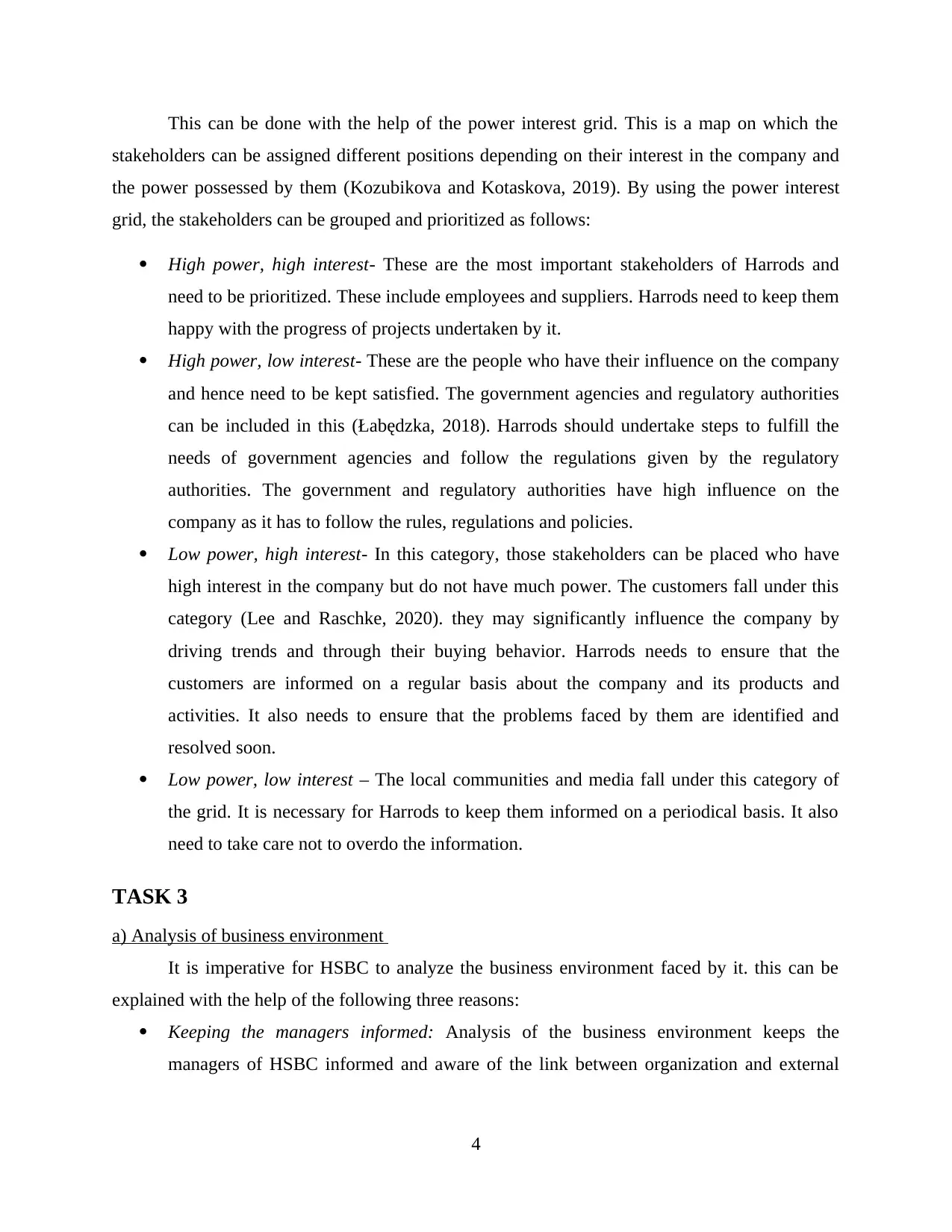
This can be done with the help of the power interest grid. This is a map on which the
stakeholders can be assigned different positions depending on their interest in the company and
the power possessed by them (Kozubikova and Kotaskova, 2019). By using the power interest
grid, the stakeholders can be grouped and prioritized as follows:
High power, high interest- These are the most important stakeholders of Harrods and
need to be prioritized. These include employees and suppliers. Harrods need to keep them
happy with the progress of projects undertaken by it.
High power, low interest- These are the people who have their influence on the company
and hence need to be kept satisfied. The government agencies and regulatory authorities
can be included in this (Łabędzka, 2018). Harrods should undertake steps to fulfill the
needs of government agencies and follow the regulations given by the regulatory
authorities. The government and regulatory authorities have high influence on the
company as it has to follow the rules, regulations and policies.
Low power, high interest- In this category, those stakeholders can be placed who have
high interest in the company but do not have much power. The customers fall under this
category (Lee and Raschke, 2020). they may significantly influence the company by
driving trends and through their buying behavior. Harrods needs to ensure that the
customers are informed on a regular basis about the company and its products and
activities. It also needs to ensure that the problems faced by them are identified and
resolved soon.
Low power, low interest – The local communities and media fall under this category of
the grid. It is necessary for Harrods to keep them informed on a periodical basis. It also
need to take care not to overdo the information.
TASK 3
a) Analysis of business environment
It is imperative for HSBC to analyze the business environment faced by it. this can be
explained with the help of the following three reasons:
Keeping the managers informed: Analysis of the business environment keeps the
managers of HSBC informed and aware of the link between organization and external
4
stakeholders can be assigned different positions depending on their interest in the company and
the power possessed by them (Kozubikova and Kotaskova, 2019). By using the power interest
grid, the stakeholders can be grouped and prioritized as follows:
High power, high interest- These are the most important stakeholders of Harrods and
need to be prioritized. These include employees and suppliers. Harrods need to keep them
happy with the progress of projects undertaken by it.
High power, low interest- These are the people who have their influence on the company
and hence need to be kept satisfied. The government agencies and regulatory authorities
can be included in this (Łabędzka, 2018). Harrods should undertake steps to fulfill the
needs of government agencies and follow the regulations given by the regulatory
authorities. The government and regulatory authorities have high influence on the
company as it has to follow the rules, regulations and policies.
Low power, high interest- In this category, those stakeholders can be placed who have
high interest in the company but do not have much power. The customers fall under this
category (Lee and Raschke, 2020). they may significantly influence the company by
driving trends and through their buying behavior. Harrods needs to ensure that the
customers are informed on a regular basis about the company and its products and
activities. It also needs to ensure that the problems faced by them are identified and
resolved soon.
Low power, low interest – The local communities and media fall under this category of
the grid. It is necessary for Harrods to keep them informed on a periodical basis. It also
need to take care not to overdo the information.
TASK 3
a) Analysis of business environment
It is imperative for HSBC to analyze the business environment faced by it. this can be
explained with the help of the following three reasons:
Keeping the managers informed: Analysis of the business environment keeps the
managers of HSBC informed and aware of the link between organization and external
4
⊘ This is a preview!⊘
Do you want full access?
Subscribe today to unlock all pages.

Trusted by 1+ million students worldwide
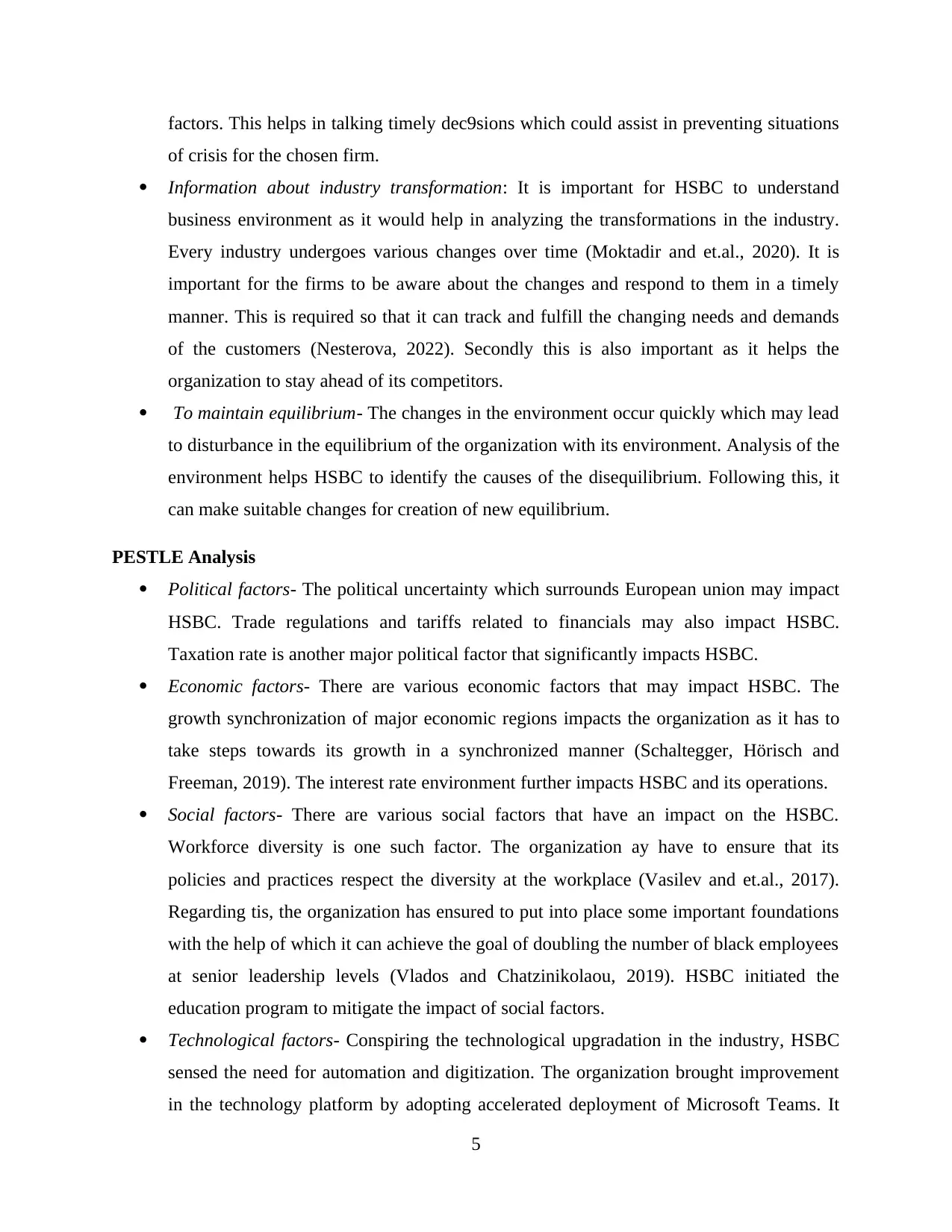
factors. This helps in talking timely dec9sions which could assist in preventing situations
of crisis for the chosen firm.
Information about industry transformation: It is important for HSBC to understand
business environment as it would help in analyzing the transformations in the industry.
Every industry undergoes various changes over time (Moktadir and et.al., 2020). It is
important for the firms to be aware about the changes and respond to them in a timely
manner. This is required so that it can track and fulfill the changing needs and demands
of the customers (Nesterova, 2022). Secondly this is also important as it helps the
organization to stay ahead of its competitors.
To maintain equilibrium- The changes in the environment occur quickly which may lead
to disturbance in the equilibrium of the organization with its environment. Analysis of the
environment helps HSBC to identify the causes of the disequilibrium. Following this, it
can make suitable changes for creation of new equilibrium.
PESTLE Analysis
Political factors- The political uncertainty which surrounds European union may impact
HSBC. Trade regulations and tariffs related to financials may also impact HSBC.
Taxation rate is another major political factor that significantly impacts HSBC.
Economic factors- There are various economic factors that may impact HSBC. The
growth synchronization of major economic regions impacts the organization as it has to
take steps towards its growth in a synchronized manner (Schaltegger, Hörisch and
Freeman, 2019). The interest rate environment further impacts HSBC and its operations.
Social factors- There are various social factors that have an impact on the HSBC.
Workforce diversity is one such factor. The organization ay have to ensure that its
policies and practices respect the diversity at the workplace (Vasilev and et.al., 2017).
Regarding tis, the organization has ensured to put into place some important foundations
with the help of which it can achieve the goal of doubling the number of black employees
at senior leadership levels (Vlados and Chatzinikolaou, 2019). HSBC initiated the
education program to mitigate the impact of social factors.
Technological factors- Conspiring the technological upgradation in the industry, HSBC
sensed the need for automation and digitization. The organization brought improvement
in the technology platform by adopting accelerated deployment of Microsoft Teams. It
5
of crisis for the chosen firm.
Information about industry transformation: It is important for HSBC to understand
business environment as it would help in analyzing the transformations in the industry.
Every industry undergoes various changes over time (Moktadir and et.al., 2020). It is
important for the firms to be aware about the changes and respond to them in a timely
manner. This is required so that it can track and fulfill the changing needs and demands
of the customers (Nesterova, 2022). Secondly this is also important as it helps the
organization to stay ahead of its competitors.
To maintain equilibrium- The changes in the environment occur quickly which may lead
to disturbance in the equilibrium of the organization with its environment. Analysis of the
environment helps HSBC to identify the causes of the disequilibrium. Following this, it
can make suitable changes for creation of new equilibrium.
PESTLE Analysis
Political factors- The political uncertainty which surrounds European union may impact
HSBC. Trade regulations and tariffs related to financials may also impact HSBC.
Taxation rate is another major political factor that significantly impacts HSBC.
Economic factors- There are various economic factors that may impact HSBC. The
growth synchronization of major economic regions impacts the organization as it has to
take steps towards its growth in a synchronized manner (Schaltegger, Hörisch and
Freeman, 2019). The interest rate environment further impacts HSBC and its operations.
Social factors- There are various social factors that have an impact on the HSBC.
Workforce diversity is one such factor. The organization ay have to ensure that its
policies and practices respect the diversity at the workplace (Vasilev and et.al., 2017).
Regarding tis, the organization has ensured to put into place some important foundations
with the help of which it can achieve the goal of doubling the number of black employees
at senior leadership levels (Vlados and Chatzinikolaou, 2019). HSBC initiated the
education program to mitigate the impact of social factors.
Technological factors- Conspiring the technological upgradation in the industry, HSBC
sensed the need for automation and digitization. The organization brought improvement
in the technology platform by adopting accelerated deployment of Microsoft Teams. It
5
Paraphrase This Document
Need a fresh take? Get an instant paraphrase of this document with our AI Paraphraser
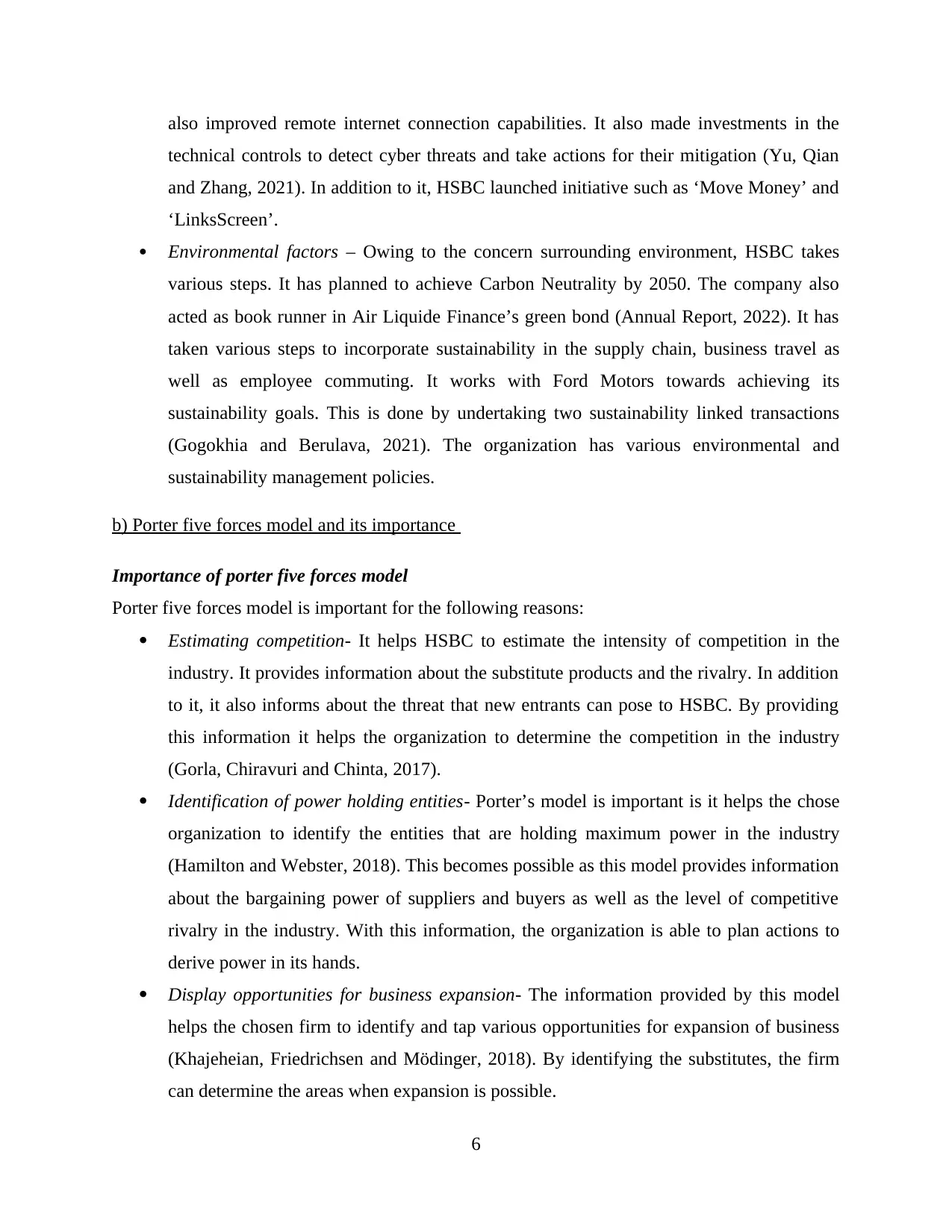
also improved remote internet connection capabilities. It also made investments in the
technical controls to detect cyber threats and take actions for their mitigation (Yu, Qian
and Zhang, 2021). In addition to it, HSBC launched initiative such as ‘Move Money’ and
‘LinksScreen’.
Environmental factors – Owing to the concern surrounding environment, HSBC takes
various steps. It has planned to achieve Carbon Neutrality by 2050. The company also
acted as book runner in Air Liquide Finance’s green bond (Annual Report, 2022). It has
taken various steps to incorporate sustainability in the supply chain, business travel as
well as employee commuting. It works with Ford Motors towards achieving its
sustainability goals. This is done by undertaking two sustainability linked transactions
(Gogokhia and Berulava, 2021). The organization has various environmental and
sustainability management policies.
b) Porter five forces model and its importance
Importance of porter five forces model
Porter five forces model is important for the following reasons:
Estimating competition- It helps HSBC to estimate the intensity of competition in the
industry. It provides information about the substitute products and the rivalry. In addition
to it, it also informs about the threat that new entrants can pose to HSBC. By providing
this information it helps the organization to determine the competition in the industry
(Gorla, Chiravuri and Chinta, 2017).
Identification of power holding entities- Porter’s model is important is it helps the chose
organization to identify the entities that are holding maximum power in the industry
(Hamilton and Webster, 2018). This becomes possible as this model provides information
about the bargaining power of suppliers and buyers as well as the level of competitive
rivalry in the industry. With this information, the organization is able to plan actions to
derive power in its hands.
Display opportunities for business expansion- The information provided by this model
helps the chosen firm to identify and tap various opportunities for expansion of business
(Khajeheian, Friedrichsen and Mödinger, 2018). By identifying the substitutes, the firm
can determine the areas when expansion is possible.
6
technical controls to detect cyber threats and take actions for their mitigation (Yu, Qian
and Zhang, 2021). In addition to it, HSBC launched initiative such as ‘Move Money’ and
‘LinksScreen’.
Environmental factors – Owing to the concern surrounding environment, HSBC takes
various steps. It has planned to achieve Carbon Neutrality by 2050. The company also
acted as book runner in Air Liquide Finance’s green bond (Annual Report, 2022). It has
taken various steps to incorporate sustainability in the supply chain, business travel as
well as employee commuting. It works with Ford Motors towards achieving its
sustainability goals. This is done by undertaking two sustainability linked transactions
(Gogokhia and Berulava, 2021). The organization has various environmental and
sustainability management policies.
b) Porter five forces model and its importance
Importance of porter five forces model
Porter five forces model is important for the following reasons:
Estimating competition- It helps HSBC to estimate the intensity of competition in the
industry. It provides information about the substitute products and the rivalry. In addition
to it, it also informs about the threat that new entrants can pose to HSBC. By providing
this information it helps the organization to determine the competition in the industry
(Gorla, Chiravuri and Chinta, 2017).
Identification of power holding entities- Porter’s model is important is it helps the chose
organization to identify the entities that are holding maximum power in the industry
(Hamilton and Webster, 2018). This becomes possible as this model provides information
about the bargaining power of suppliers and buyers as well as the level of competitive
rivalry in the industry. With this information, the organization is able to plan actions to
derive power in its hands.
Display opportunities for business expansion- The information provided by this model
helps the chosen firm to identify and tap various opportunities for expansion of business
(Khajeheian, Friedrichsen and Mödinger, 2018). By identifying the substitutes, the firm
can determine the areas when expansion is possible.
6
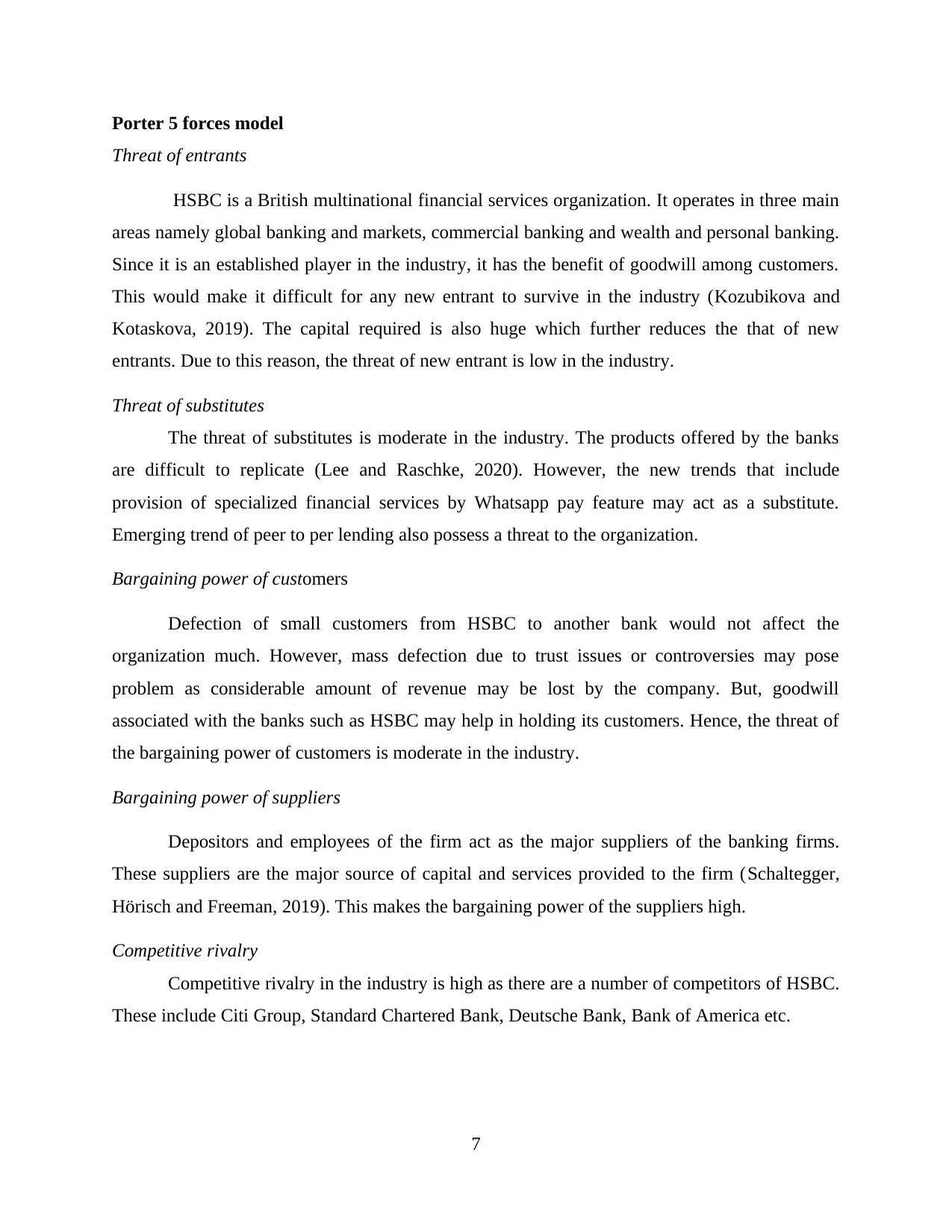
Porter 5 forces model
Threat of entrants
HSBC is a British multinational financial services organization. It operates in three main
areas namely global banking and markets, commercial banking and wealth and personal banking.
Since it is an established player in the industry, it has the benefit of goodwill among customers.
This would make it difficult for any new entrant to survive in the industry (Kozubikova and
Kotaskova, 2019). The capital required is also huge which further reduces the that of new
entrants. Due to this reason, the threat of new entrant is low in the industry.
Threat of substitutes
The threat of substitutes is moderate in the industry. The products offered by the banks
are difficult to replicate (Lee and Raschke, 2020). However, the new trends that include
provision of specialized financial services by Whatsapp pay feature may act as a substitute.
Emerging trend of peer to per lending also possess a threat to the organization.
Bargaining power of customers
Defection of small customers from HSBC to another bank would not affect the
organization much. However, mass defection due to trust issues or controversies may pose
problem as considerable amount of revenue may be lost by the company. But, goodwill
associated with the banks such as HSBC may help in holding its customers. Hence, the threat of
the bargaining power of customers is moderate in the industry.
Bargaining power of suppliers
Depositors and employees of the firm act as the major suppliers of the banking firms.
These suppliers are the major source of capital and services provided to the firm (Schaltegger,
Hörisch and Freeman, 2019). This makes the bargaining power of the suppliers high.
Competitive rivalry
Competitive rivalry in the industry is high as there are a number of competitors of HSBC.
These include Citi Group, Standard Chartered Bank, Deutsche Bank, Bank of America etc.
7
Threat of entrants
HSBC is a British multinational financial services organization. It operates in three main
areas namely global banking and markets, commercial banking and wealth and personal banking.
Since it is an established player in the industry, it has the benefit of goodwill among customers.
This would make it difficult for any new entrant to survive in the industry (Kozubikova and
Kotaskova, 2019). The capital required is also huge which further reduces the that of new
entrants. Due to this reason, the threat of new entrant is low in the industry.
Threat of substitutes
The threat of substitutes is moderate in the industry. The products offered by the banks
are difficult to replicate (Lee and Raschke, 2020). However, the new trends that include
provision of specialized financial services by Whatsapp pay feature may act as a substitute.
Emerging trend of peer to per lending also possess a threat to the organization.
Bargaining power of customers
Defection of small customers from HSBC to another bank would not affect the
organization much. However, mass defection due to trust issues or controversies may pose
problem as considerable amount of revenue may be lost by the company. But, goodwill
associated with the banks such as HSBC may help in holding its customers. Hence, the threat of
the bargaining power of customers is moderate in the industry.
Bargaining power of suppliers
Depositors and employees of the firm act as the major suppliers of the banking firms.
These suppliers are the major source of capital and services provided to the firm (Schaltegger,
Hörisch and Freeman, 2019). This makes the bargaining power of the suppliers high.
Competitive rivalry
Competitive rivalry in the industry is high as there are a number of competitors of HSBC.
These include Citi Group, Standard Chartered Bank, Deutsche Bank, Bank of America etc.
7
⊘ This is a preview!⊘
Do you want full access?
Subscribe today to unlock all pages.

Trusted by 1+ million students worldwide
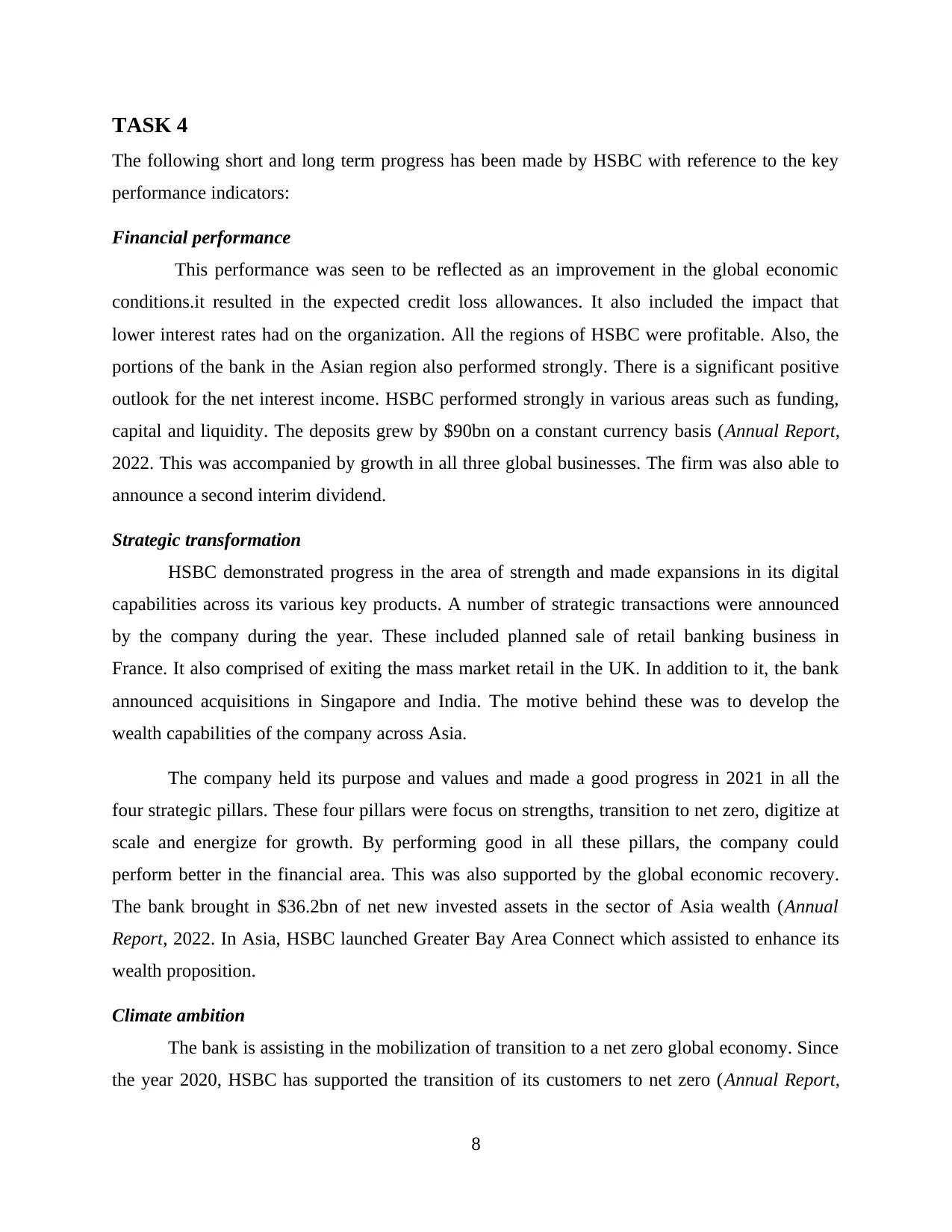
TASK 4
The following short and long term progress has been made by HSBC with reference to the key
performance indicators:
Financial performance
This performance was seen to be reflected as an improvement in the global economic
conditions.it resulted in the expected credit loss allowances. It also included the impact that
lower interest rates had on the organization. All the regions of HSBC were profitable. Also, the
portions of the bank in the Asian region also performed strongly. There is a significant positive
outlook for the net interest income. HSBC performed strongly in various areas such as funding,
capital and liquidity. The deposits grew by $90bn on a constant currency basis (Annual Report,
2022. This was accompanied by growth in all three global businesses. The firm was also able to
announce a second interim dividend.
Strategic transformation
HSBC demonstrated progress in the area of strength and made expansions in its digital
capabilities across its various key products. A number of strategic transactions were announced
by the company during the year. These included planned sale of retail banking business in
France. It also comprised of exiting the mass market retail in the UK. In addition to it, the bank
announced acquisitions in Singapore and India. The motive behind these was to develop the
wealth capabilities of the company across Asia.
The company held its purpose and values and made a good progress in 2021 in all the
four strategic pillars. These four pillars were focus on strengths, transition to net zero, digitize at
scale and energize for growth. By performing good in all these pillars, the company could
perform better in the financial area. This was also supported by the global economic recovery.
The bank brought in $36.2bn of net new invested assets in the sector of Asia wealth (Annual
Report, 2022. In Asia, HSBC launched Greater Bay Area Connect which assisted to enhance its
wealth proposition.
Climate ambition
The bank is assisting in the mobilization of transition to a net zero global economy. Since
the year 2020, HSBC has supported the transition of its customers to net zero (Annual Report,
8
The following short and long term progress has been made by HSBC with reference to the key
performance indicators:
Financial performance
This performance was seen to be reflected as an improvement in the global economic
conditions.it resulted in the expected credit loss allowances. It also included the impact that
lower interest rates had on the organization. All the regions of HSBC were profitable. Also, the
portions of the bank in the Asian region also performed strongly. There is a significant positive
outlook for the net interest income. HSBC performed strongly in various areas such as funding,
capital and liquidity. The deposits grew by $90bn on a constant currency basis (Annual Report,
2022. This was accompanied by growth in all three global businesses. The firm was also able to
announce a second interim dividend.
Strategic transformation
HSBC demonstrated progress in the area of strength and made expansions in its digital
capabilities across its various key products. A number of strategic transactions were announced
by the company during the year. These included planned sale of retail banking business in
France. It also comprised of exiting the mass market retail in the UK. In addition to it, the bank
announced acquisitions in Singapore and India. The motive behind these was to develop the
wealth capabilities of the company across Asia.
The company held its purpose and values and made a good progress in 2021 in all the
four strategic pillars. These four pillars were focus on strengths, transition to net zero, digitize at
scale and energize for growth. By performing good in all these pillars, the company could
perform better in the financial area. This was also supported by the global economic recovery.
The bank brought in $36.2bn of net new invested assets in the sector of Asia wealth (Annual
Report, 2022. In Asia, HSBC launched Greater Bay Area Connect which assisted to enhance its
wealth proposition.
Climate ambition
The bank is assisting in the mobilization of transition to a net zero global economy. Since
the year 2020, HSBC has supported the transition of its customers to net zero (Annual Report,
8
Paraphrase This Document
Need a fresh take? Get an instant paraphrase of this document with our AI Paraphraser
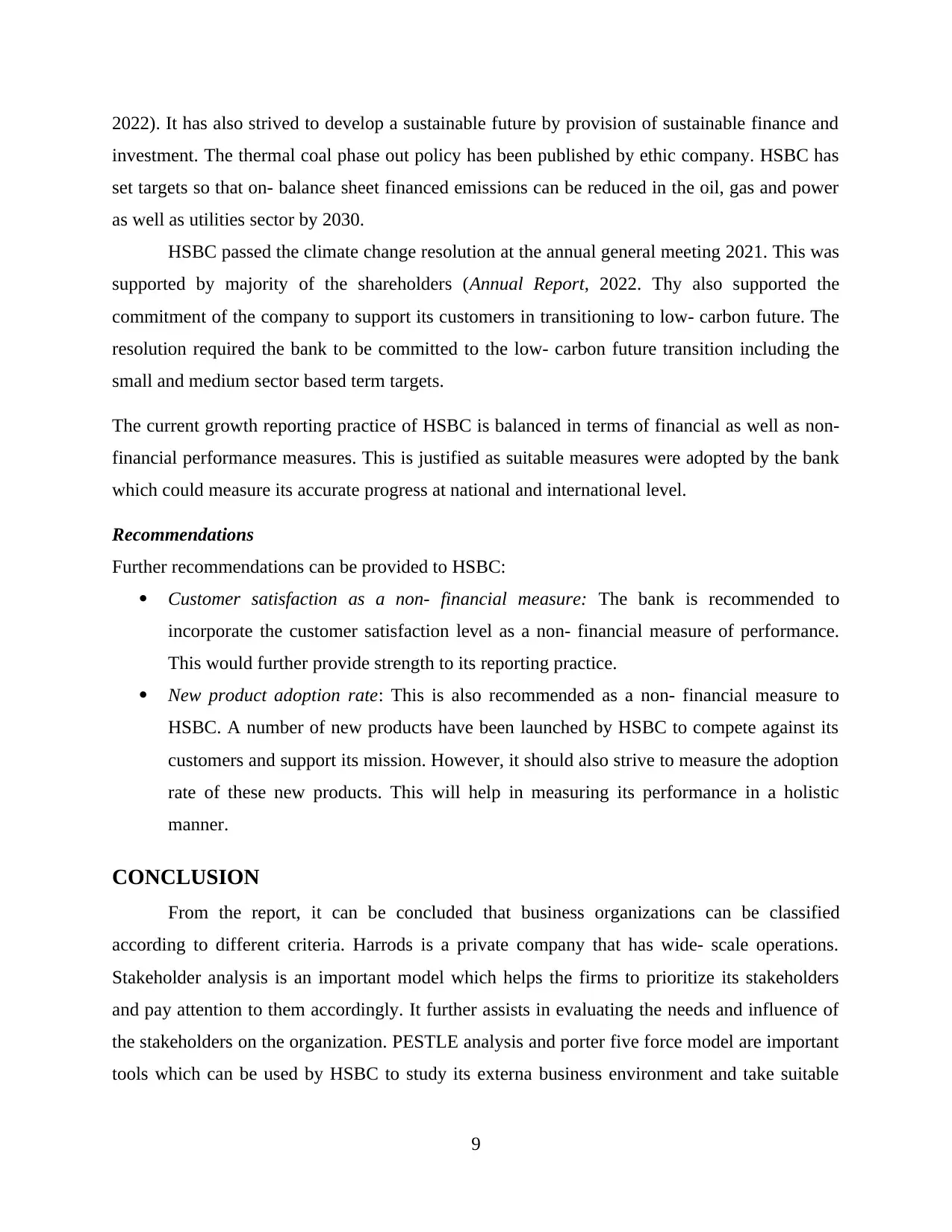
2022). It has also strived to develop a sustainable future by provision of sustainable finance and
investment. The thermal coal phase out policy has been published by ethic company. HSBC has
set targets so that on- balance sheet financed emissions can be reduced in the oil, gas and power
as well as utilities sector by 2030.
HSBC passed the climate change resolution at the annual general meeting 2021. This was
supported by majority of the shareholders (Annual Report, 2022. Thy also supported the
commitment of the company to support its customers in transitioning to low- carbon future. The
resolution required the bank to be committed to the low- carbon future transition including the
small and medium sector based term targets.
The current growth reporting practice of HSBC is balanced in terms of financial as well as non-
financial performance measures. This is justified as suitable measures were adopted by the bank
which could measure its accurate progress at national and international level.
Recommendations
Further recommendations can be provided to HSBC:
Customer satisfaction as a non- financial measure: The bank is recommended to
incorporate the customer satisfaction level as a non- financial measure of performance.
This would further provide strength to its reporting practice.
New product adoption rate: This is also recommended as a non- financial measure to
HSBC. A number of new products have been launched by HSBC to compete against its
customers and support its mission. However, it should also strive to measure the adoption
rate of these new products. This will help in measuring its performance in a holistic
manner.
CONCLUSION
From the report, it can be concluded that business organizations can be classified
according to different criteria. Harrods is a private company that has wide- scale operations.
Stakeholder analysis is an important model which helps the firms to prioritize its stakeholders
and pay attention to them accordingly. It further assists in evaluating the needs and influence of
the stakeholders on the organization. PESTLE analysis and porter five force model are important
tools which can be used by HSBC to study its externa business environment and take suitable
9
investment. The thermal coal phase out policy has been published by ethic company. HSBC has
set targets so that on- balance sheet financed emissions can be reduced in the oil, gas and power
as well as utilities sector by 2030.
HSBC passed the climate change resolution at the annual general meeting 2021. This was
supported by majority of the shareholders (Annual Report, 2022. Thy also supported the
commitment of the company to support its customers in transitioning to low- carbon future. The
resolution required the bank to be committed to the low- carbon future transition including the
small and medium sector based term targets.
The current growth reporting practice of HSBC is balanced in terms of financial as well as non-
financial performance measures. This is justified as suitable measures were adopted by the bank
which could measure its accurate progress at national and international level.
Recommendations
Further recommendations can be provided to HSBC:
Customer satisfaction as a non- financial measure: The bank is recommended to
incorporate the customer satisfaction level as a non- financial measure of performance.
This would further provide strength to its reporting practice.
New product adoption rate: This is also recommended as a non- financial measure to
HSBC. A number of new products have been launched by HSBC to compete against its
customers and support its mission. However, it should also strive to measure the adoption
rate of these new products. This will help in measuring its performance in a holistic
manner.
CONCLUSION
From the report, it can be concluded that business organizations can be classified
according to different criteria. Harrods is a private company that has wide- scale operations.
Stakeholder analysis is an important model which helps the firms to prioritize its stakeholders
and pay attention to them accordingly. It further assists in evaluating the needs and influence of
the stakeholders on the organization. PESTLE analysis and porter five force model are important
tools which can be used by HSBC to study its externa business environment and take suitable
9
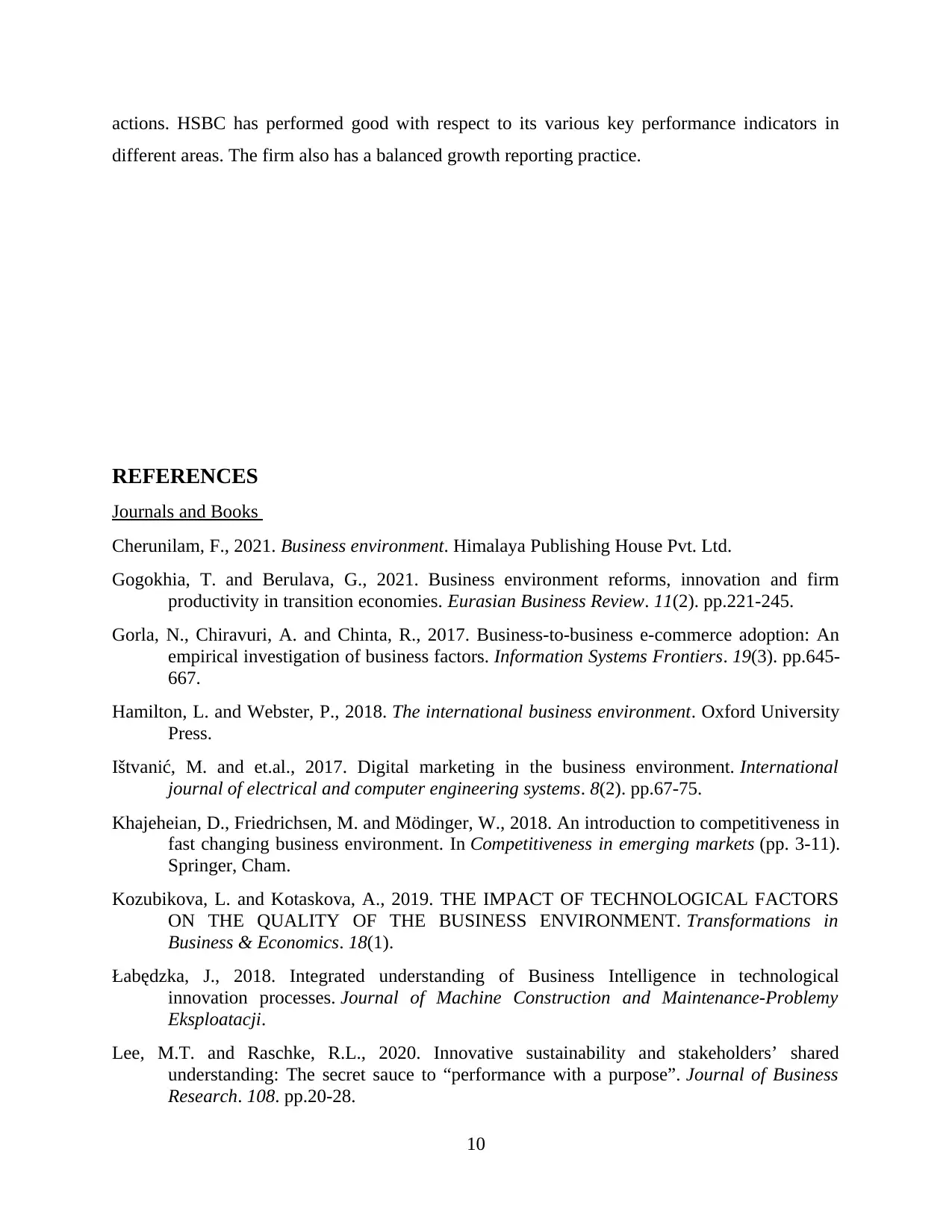
actions. HSBC has performed good with respect to its various key performance indicators in
different areas. The firm also has a balanced growth reporting practice.
REFERENCES
Journals and Books
Cherunilam, F., 2021. Business environment. Himalaya Publishing House Pvt. Ltd.
Gogokhia, T. and Berulava, G., 2021. Business environment reforms, innovation and firm
productivity in transition economies. Eurasian Business Review. 11(2). pp.221-245.
Gorla, N., Chiravuri, A. and Chinta, R., 2017. Business-to-business e-commerce adoption: An
empirical investigation of business factors. Information Systems Frontiers. 19(3). pp.645-
667.
Hamilton, L. and Webster, P., 2018. The international business environment. Oxford University
Press.
Ištvanić, M. and et.al., 2017. Digital marketing in the business environment. International
journal of electrical and computer engineering systems. 8(2). pp.67-75.
Khajeheian, D., Friedrichsen, M. and Mödinger, W., 2018. An introduction to competitiveness in
fast changing business environment. In Competitiveness in emerging markets (pp. 3-11).
Springer, Cham.
Kozubikova, L. and Kotaskova, A., 2019. THE IMPACT OF TECHNOLOGICAL FACTORS
ON THE QUALITY OF THE BUSINESS ENVIRONMENT. Transformations in
Business & Economics. 18(1).
Łabędzka, J., 2018. Integrated understanding of Business Intelligence in technological
innovation processes. Journal of Machine Construction and Maintenance-Problemy
Eksploatacji.
Lee, M.T. and Raschke, R.L., 2020. Innovative sustainability and stakeholders’ shared
understanding: The secret sauce to “performance with a purpose”. Journal of Business
Research. 108. pp.20-28.
10
different areas. The firm also has a balanced growth reporting practice.
REFERENCES
Journals and Books
Cherunilam, F., 2021. Business environment. Himalaya Publishing House Pvt. Ltd.
Gogokhia, T. and Berulava, G., 2021. Business environment reforms, innovation and firm
productivity in transition economies. Eurasian Business Review. 11(2). pp.221-245.
Gorla, N., Chiravuri, A. and Chinta, R., 2017. Business-to-business e-commerce adoption: An
empirical investigation of business factors. Information Systems Frontiers. 19(3). pp.645-
667.
Hamilton, L. and Webster, P., 2018. The international business environment. Oxford University
Press.
Ištvanić, M. and et.al., 2017. Digital marketing in the business environment. International
journal of electrical and computer engineering systems. 8(2). pp.67-75.
Khajeheian, D., Friedrichsen, M. and Mödinger, W., 2018. An introduction to competitiveness in
fast changing business environment. In Competitiveness in emerging markets (pp. 3-11).
Springer, Cham.
Kozubikova, L. and Kotaskova, A., 2019. THE IMPACT OF TECHNOLOGICAL FACTORS
ON THE QUALITY OF THE BUSINESS ENVIRONMENT. Transformations in
Business & Economics. 18(1).
Łabędzka, J., 2018. Integrated understanding of Business Intelligence in technological
innovation processes. Journal of Machine Construction and Maintenance-Problemy
Eksploatacji.
Lee, M.T. and Raschke, R.L., 2020. Innovative sustainability and stakeholders’ shared
understanding: The secret sauce to “performance with a purpose”. Journal of Business
Research. 108. pp.20-28.
10
⊘ This is a preview!⊘
Do you want full access?
Subscribe today to unlock all pages.

Trusted by 1+ million students worldwide
1 out of 13
Related Documents
Your All-in-One AI-Powered Toolkit for Academic Success.
+13062052269
info@desklib.com
Available 24*7 on WhatsApp / Email
![[object Object]](/_next/static/media/star-bottom.7253800d.svg)
Unlock your academic potential
Copyright © 2020–2025 A2Z Services. All Rights Reserved. Developed and managed by ZUCOL.




